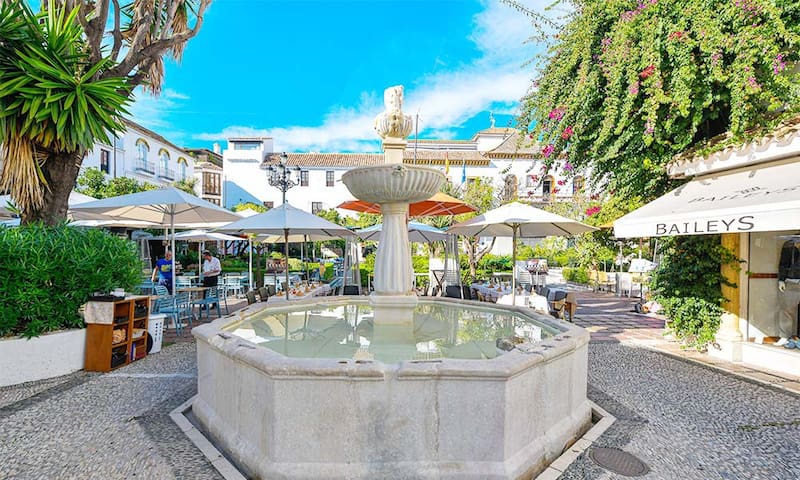Barrios
Marbella preserves the traces of a historical process that is both interesting and extensive in time. Its beginnings date back to the Roman period, though it can be said that the historic centre is the result of a Muslim settlement, where architectural remains, archaeological vestiges and testimonies by chronicles and travellers from the 12th century onwards converge, since it is from this century that Marbella began its development to the north with calle Ancha. One century later it spread to the east with Barrio Nuevo, around what is now calle Málaga, where Cruz del Humilladero is located.
55 lokalkjente anbefaler
Old Town
Marbella preserves the traces of a historical process that is both interesting and extensive in time. Its beginnings date back to the Roman period, though it can be said that the historic centre is the result of a Muslim settlement, where architectural remains, archaeological vestiges and testimonies by chronicles and travellers from the 12th century onwards converge, since it is from this century that Marbella began its development to the north with calle Ancha. One century later it spread to the east with Barrio Nuevo, around what is now calle Málaga, where Cruz del Humilladero is located.
Lugares emblemáticos
This square is indisputably the heart of Marbella old town. Here you can enjoy some of the city’s most beautiful monuments.
While the old town is full of squares and beautiful corners, this square has something captivating, albeit hard to explain.
310 lokalkjente anbefaler
Plaza de los Naranjos
Plaza de los NaranjosThis square is indisputably the heart of Marbella old town. Here you can enjoy some of the city’s most beautiful monuments.
While the old town is full of squares and beautiful corners, this square has something captivating, albeit hard to explain.
The Arab Castle is located a short distance from Plaza de los Naranjos and from the Church of the Incarnation. It is a Muslim construction that was erected by Abderraman III, and of what is currently visible, two towers and the College of Our Lady of Carmen today stand where the arms yard was. It has also been a Site of Cultural Interest since 1949.
20 lokalkjente anbefaler
Muralla del Castillo de Marbella
11 C. PortadaThe Arab Castle is located a short distance from Plaza de los Naranjos and from the Church of the Incarnation. It is a Muslim construction that was erected by Abderraman III, and of what is currently visible, two towers and the College of Our Lady of Carmen today stand where the arms yard was. It has also been a Site of Cultural Interest since 1949.
Marbella’s Alameda represents a vital element in its history, a high-identity place, one of reference because it was the recreation and meeting spot of the City’s inhabitants.
The first existing data on the opening of the park date back to the 18th century. In a document dated 1761 the existence is noted of a promenade where planted black poplars were watered through small moats providing abundant water, complemented a year later with a fountain at one of its extremes.
A century later, in 1868, this Marbella park experienced a major and timely transformation thanks to the sale of some City plots to the English mining company "Marbella Iron Ore".
Nowadays its oldest feature is the fountain located in the eastern section of the park, built in 1762, known by the people of Marbella as “La Pila”. Within the area’s lush greenery centuries-old Araucarias (monkey-puzzle trees) and Buttonwood trees are found, both species planted last century, between 1910 and 1920.
59 lokalkjente anbefaler
Alameda Park
s/n Av. Ramón y CajalMarbella’s Alameda represents a vital element in its history, a high-identity place, one of reference because it was the recreation and meeting spot of the City’s inhabitants.
The first existing data on the opening of the park date back to the 18th century. In a document dated 1761 the existence is noted of a promenade where planted black poplars were watered through small moats providing abundant water, complemented a year later with a fountain at one of its extremes.
A century later, in 1868, this Marbella park experienced a major and timely transformation thanks to the sale of some City plots to the English mining company "Marbella Iron Ore".
Nowadays its oldest feature is the fountain located in the eastern section of the park, built in 1762, known by the people of Marbella as “La Pila”. Within the area’s lush greenery centuries-old Araucarias (monkey-puzzle trees) and Buttonwood trees are found, both species planted last century, between 1910 and 1920.
Gastronomía
One of the best tipical fish restaurant on Marbella, low prices and good quality.
21 lokalkjente anbefaler
El Cordobes
7 C. ArteOne of the best tipical fish restaurant on Marbella, low prices and good quality.
Restaurante El Cortijo
5 C. RemediosBar El Tarifa
1 Calle Juan Brevaif you don't want to cook, this is perfect to enjoy in our terrace, for just 5€
Pizzeria Todo Pizza El Canijo
1 Calle Virgen del Amparoif you don't want to cook, this is perfect to enjoy in our terrace, for just 5€
Bar La Morenita
14 Avenida Independencia

